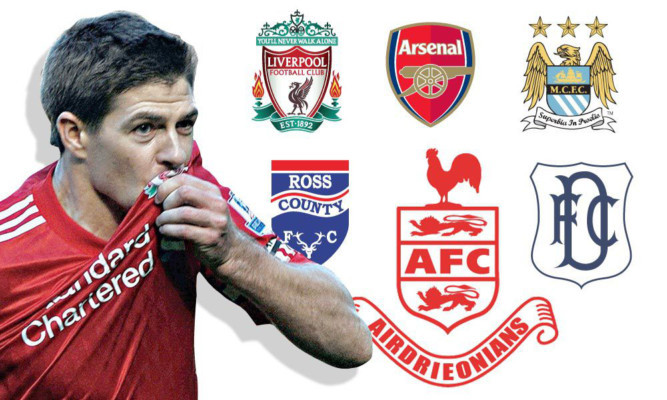
“Action is already being taken against Scottish side Airdrieonians, who have received a letter warning them to get a new badge or face prosecution.”
Top football clubs on both sides of the border could be at risk of losing their historic badges because they break a 500-year-old law.
Arsenal, Manchester City, Liverpool, Dundee and Ross County are just five of the dozens of sides potentially falling foul of ancient heraldry legislation which demands that no letters or numbers are used in shield-shaped crests.
As loopy as it may sound, the footballing super-powers could be forced to change their badges if legal authorities on ancestry deem them “heraldic devices”.
Action is already being taken against Scottish side Airdrieonians, who have received a letter warning them to get a new badge or face prosecution all because the crest they’ve used since 1950 contains letters within a shield.
It’s now emerged scores of other top teams could face the same fate.
A Scottish Parliament Act passed in 1592 gives the court of the Lord Lyon responsibility for prosecuting anyone who uses unauthorised arms. Similar laws are in place south of the border.
Mark Hamid, secretary to the Lord Lyon in Scotland, said: “Off the top of my head there are only a few teams who have registered their badges St Mirren and Queens Park.
“Clubs that choose a design that isn’t in any way heraldic wouldn’t have to consider registering, but those who do should.”
His English equivalent, Peter O’Donoghue, who is York Herald at the College of Arms, added: “It’s a bit of a grey area. A lot of the logos used by football teams are very similar to heraldic devices because they use the shape of the shield.
“No football team in England, as far as I’m aware, has registered their badge. I don’t know why that is, if it’s just because of the history of football.
“But they’ve recently become big businesses and, as such, we would encourage them to register. If they are using unregistered shield shapes which contain letters, then what they are doing may well be unlawful.”
Heraldic devices which are most commonly coats of arms were first used in the 16th Century, painted on wooden shields to help identify people in battle.
In Scotland they all had to be signed-off by the Court of the Lord Lyon, and could only use images to portray character or meaning.
Airdrie’s crest, which contains two lions and the letters AFC inside a shield, was reported to the Lord Lyon by the UK Intellectual Property Office after a mystery third party tried to trademark it. The club then received the letter warning them it broke the law.
Diamonds chairman Jim Ballantyne has since agreed to replace the badge, angering supporters.
We found 40 professional teams in Scotland’s top six tiers and England’s top two who could all be asked to redesign their club badges, because they either contain text or common heraldic images, such as animals, in their shielded crests.
SPFL clubs and teams from the Highland and Lowland leagues all feature, alongside English clubs including Aston Villa, QPR and Ipswich.
While breaching the regulations is a criminal offence north of the border, English rules only deem the unauthorised use of a heraldic device punishable in a civic court.
Mark Hamid added: “A heraldic device would probably have to involve a shield. There are all sorts of logos which we wouldn’t consider to be heraldic.”
If Scottish teams would want to keep the shielded outline of their badge after removing any text, they’d have to pay between £3,000 and £4,000 to do so.
In England, that fee is an eye-watering £17,000.
In 2010, Highland League side Formartine United were reported for using a Saltire in their 53-year-old badge without permission.
They, like Airdrieonians, had to design a new club crest.
Airdrie supporter Colin Telford has submitted a petition to the Scottish Parliament with the aim of protecting all Scottish football club badges from the Lord Lyon.
Clubs just the latest to bear brunt of 1592 law
The ruling on football badges isn’t the first time ancient heraldry laws have had an impact on modern life.
In 2000, it was revealed scores of Scottish schools had failed to register their emblems with the Court of the Lord Lyon. There were fears it could result in a bill of around £100,000 to local authorities. But it then turned into a much bigger problem.
Two years later, it was revealed that half of all Scottish state schools around 1,500 were required to pay an £830 bill to register their badges. The then Scottish Executive attacked the Lord Lyon for eating into the education budget.
The former Fife police constabulary also faced a bill after falling foul of the 1592 law. It decided to embark on a massive redesign job to get around it.
Others failing to understand heraldic etiquette include Egyptian businessman Mohammed Al-Fayed. The Scots-loving Harrods boss had been using a coat of arms from the Ross clan on the gates of his Highland home in Ross-shire.
But under pressure from the heraldic watchdog he was forced to remove it in 2000.

Enjoy the convenience of having The Sunday Post delivered as a digital ePaper straight to your smartphone, tablet or computer.
Subscribe for only £5.49 a month and enjoy all the benefits of the printed paper as a digital replica.
Subscribe